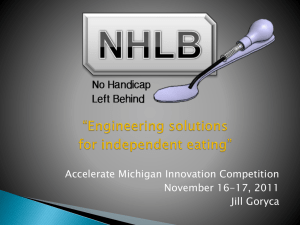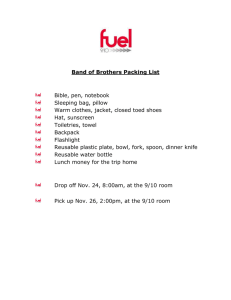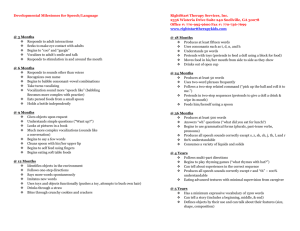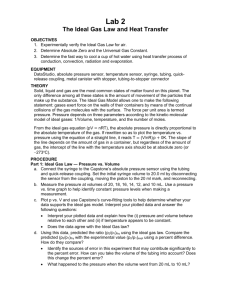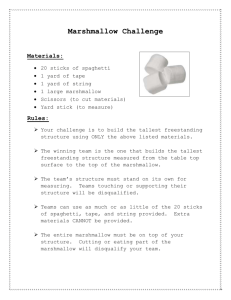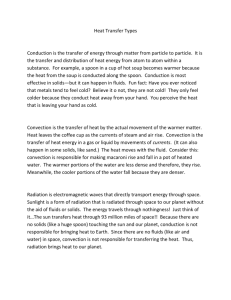Marshmallow Launcher Lab Advanced | 319.9KB
advertisement
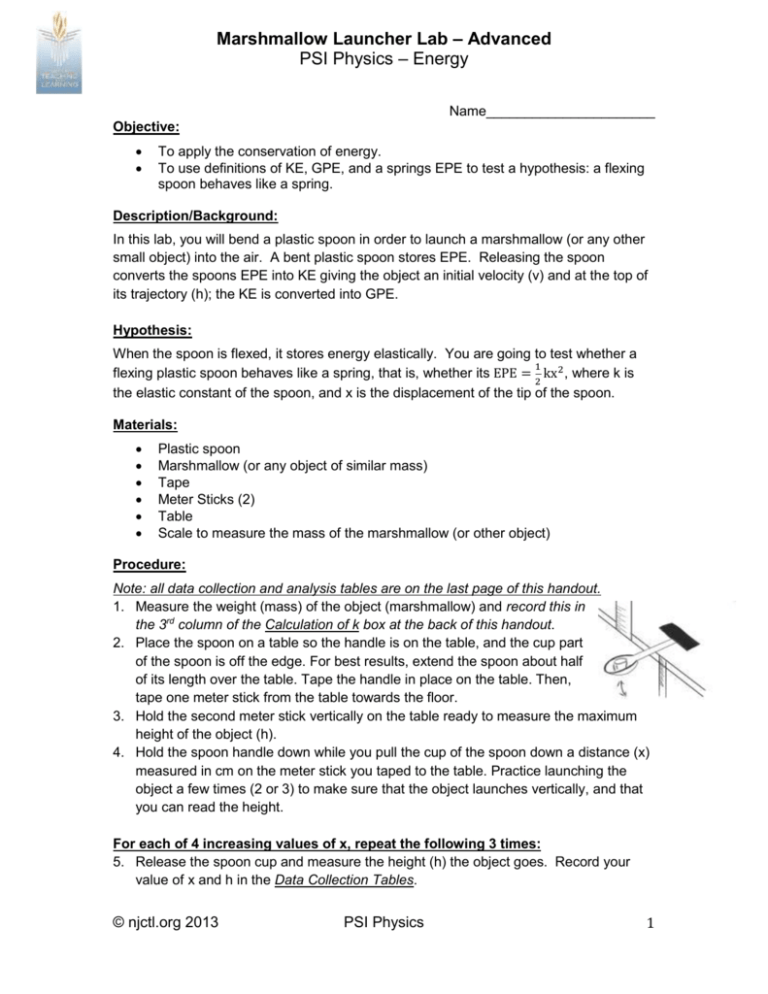
Marshmallow Launcher Lab – Advanced PSI Physics – Energy Name______________________ Objective: To apply the conservation of energy. To use definitions of KE, GPE, and a springs EPE to test a hypothesis: a flexing spoon behaves like a spring. Description/Background: In this lab, you will bend a plastic spoon in order to launch a marshmallow (or any other small object) into the air. A bent plastic spoon stores EPE. Releasing the spoon converts the spoons EPE into KE giving the object an initial velocity (v) and at the top of its trajectory (h); the KE is converted into GPE. Hypothesis: When the spoon is flexed, it stores energy elastically. You are going to test whether a 1 flexing plastic spoon behaves like a spring, that is, whether its EPE = 2 kx 2 , where k is the elastic constant of the spoon, and x is the displacement of the tip of the spoon. Materials: Plastic spoon Marshmallow (or any object of similar mass) Tape Meter Sticks (2) Table Scale to measure the mass of the marshmallow (or other object) Procedure: Note: all data collection and analysis tables are on the last page of this handout. 1. Measure the weight (mass) of the object (marshmallow) and record this in the 3rd column of the Calculation of k box at the back of this handout. 2. Place the spoon on a table so the handle is on the table, and the cup part of the spoon is off the edge. For best results, extend the spoon about half of its length over the table. Tape the handle in place on the table. Then, tape one meter stick from the table towards the floor. 3. Hold the second meter stick vertically on the table ready to measure the maximum height of the object (h). 4. Hold the spoon handle down while you pull the cup of the spoon down a distance (x) measured in cm on the meter stick you taped to the table. Practice launching the object a few times (2 or 3) to make sure that the object launches vertically, and that you can read the height. For each of 4 increasing values of x, repeat the following 3 times: 5. Release the spoon cup and measure the height (h) the object goes. Record your value of x and h in the Data Collection Tables. © njctl.org 2013 PSI Physics 1 Marshmallow Launcher Lab – Advanced PSI Physics – Energy Data Analysis: 1. Calculate average values of h for each value of x and record these in the last row of the appropriate Data Collection Table. 2. Calculate k by following the steps in the Calculation of k box 3. Copy each value of x with its associated average value of hexp into the appropriate place in the Predicting h table. 4. Copy the value of m and the calculated k from this box into the adjoining Predicting h table 5. Complete the Predicting h table to find hpredicted for each value of x. Analysis: 1. For each x, are your predicted and experimental values of h fairly close or very different from your predicted values of h? You can check this by graphing hexp vs hpredicted for each x: If hexp and hpredicted are the same, the will lie on the line with slope 1 on the graph. Do your points follow the line fairly closely, sloping off slightly or close to the line on either side, or are they wildly off? © njctl.org 2013 PSI Physics 2 Marshmallow Launcher Lab – Advanced PSI Physics – Energy 2. Given the above result, would you say the hypothesis was correct, that a flexing 1 plastic spoon behaves like a spring and has EPE = 2 kx 2 , where k is the elastic constant of the spoon, and x is the displacement of the tip of the spoon? 3. Why would the calculated values of for height of the object and the experimental values differ, excluding reasons of faulty measurements and calculations? Application: A 20 kg boy stands on a diving board that is held down 0.5 meters below the horizontal by two big friends. When his friends release the board, the boy reaches a maximum height 1 meter above the horizontal. Assuming the board is a spring, what is the spring constant of the board? © njctl.org 2013 PSI Physics 3 Marshmallow Launcher Lab – Advanced PSI Physics – Energy Data Collection Tables x1 = cm x2 = cm x3 = cm x4 = cm Trial # h (m) Trial # h (m) Trial # h (m) Trial # h (m) 1 1 1 1 2 2 2 2 3 3 3 3 Average: hexp = Average: hexp = Average: hexp = Average: hexp = Calculation of k: Predicting h: 𝑥 m 𝑤𝑒𝑖𝑔ℎ𝑡 =____________N (unless you know m) 𝑚= 𝑤𝑒𝑖𝑔ℎ𝑡 𝑔 = _________ kg 𝑥1 = ___________ cm = ___________ m 𝐺𝑃𝐸 = 𝑚𝑔ℎ𝑒𝑥𝑝 = __________J 𝐸𝑃𝐸 = _____________ = 1 𝑘𝑥1 2 2 𝑘 1 𝐸𝑃𝐸 = 𝑘𝑥 2 2 𝐺𝑃𝐸 = 𝐸𝑃𝐸 ℎ𝑝𝑟𝑒𝑑𝑖𝑐𝑡𝑒𝑑 = 𝐺𝑃𝐸/𝑚𝑔 ℎ𝑒𝑥𝑝 (𝑎𝑣𝑒𝑟𝑎𝑔𝑒 ℎ) 𝑥1 𝑥2 𝑥3 𝑥4 2 𝑘 = 2 × 𝐸𝑃𝐸/𝑥1 = ________________ © njctl.org 2013 PSI Physics 4

